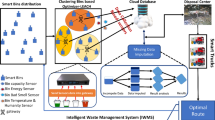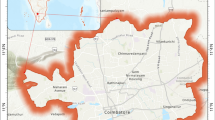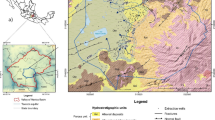Abstract
This paper presents an urban water supply network system based on GIS technology. The system will adopt three-tier/N-tier architecture as the application logic structure. Thy system can be divided into six subsystems: the analysis subsystem, the aided design subsystem, the installation and maintenance management subsystem and the customer service subsystem serve data management subsystem. The data management of the system will adopt SuperMap. We present the details of the data management, such as basic data collection, structure framework of the basic geographic information bank, the process to construct GIS basic information bank of water supply network, data conversion and input into banks, data vectorization and input into banks, etc. Then the system database is designed in detail. We adopt object oriented analysis and design methods, and utilize Class Diagram of UML to represent the entity tables and their relations against the core data of the network system, that is spatial dictionary database and spatial database. According to Class Diagram, it can be directly mapped as the database structure and an example is given. Finally, the successful application of the system in Yiyang city of China is beneficial for water supply enterprises to utilize the existing water resource in time, rationally and effectively.
Similar content being viewed by others
References
Babiker IS, Mohamed MAA, Hiyama T (2007) Assessing groundwater quality using GIS. Water Resour Manage 21(4):699–715. doi:10.1007/s11269-006-9059-6
Cech I, Montera J (2000) Spatial variations in total aluminum concentrations in drinking water supplies studied by geographic information system (GIS) methods. Water Res 34(10):2703–2712. doi:10.1016/S0043-1354(00)00026-9
Dangendorf F, Herbst S, Ralf R, Kistemann T (2002) Spatial patterns of diarrhoeal illnesses with regard to water supply structures—a GIS analysis. Int J Hyg Environ Health 205(3):183–191. doi:10.1078/1438-4639-00151
Dawoud MA, Darwish MM, El-Kady MM (2005) GIS-based groundwater management model for Western Nile Delta. Water Resour Manage 19(5):585–604. doi:10.1007/s11269-005-5603-z
Feinberg D, Uhrick SW (1997) Integrating GIS with water and wastewater hydraulic models. In: Proc. of 1997 ESRI user conference. http://www.esri.com/library/userconf/proc97/PROC/TO200/PAP199/P199.HTM
Hellweger F, Maidment D (1999) Definition and connection of hydrologic elements using geographic data. J Hydrol Eng 4(1):10–18. doi:10.1061/(ASCE)1084-0699(1999)4:1(10)
Kalivas DP, Kollias VJ, Karantounias G (2003) A GIS for the assessment of the spatio-temporal changes of the Kotychi Lagoon, Western Peloponnese, Greece. Water Resour Manage 17(1):19–36. doi:10.1023/A:1023066706852
Kesavan CHK (1972) Graph-theoretic models for pipe network analysis. J Hydraul Div 36:16–20
Kimmance JP, Bradshaw MP, Seetoh HH (1999) Geographical Information System (GIS) application to construction and geotechnical data management on MRT construction projects in Singapore. Tunneling Undergr Space Technol 14(4):469–479. doi:10.1016/S0886-7798(00)00009-2
Patil JP, Sarangi A, Singh OP, Singh AK, Ahmad T (2008) Development of a GIS interface for estimation of runoff from watersheds. Water Resour Manage 22(9):1221–1239. doi:10.1007/s11269-007-9222-8
Perez J, Roger A, Noheda E, Zoti P (2005) Geographic Information System (GIS), leakage detection, mathematical modeling project for the validation of the investment planning at Valles del Tuy adduction water network (Venezuela). Water Sci Technol 5(3–4):289–294
Schlüter M, Rüger N (2007) Application of a GIS-based simulation tool to illustrate implications of uncertainties for water management in the Amudarya river delta. Environ Model Softw 22(2):158–166. doi:10.1016/j.envsoft.2005.09.006
Shamsi UM (1998) ArcView applications in SWMM modeling, chapter 11. In: James W (ed) Advances in modeling the management of stormwater impacts, vol 6. Computational Hydraulics International, Guelph, pp 219–233
Shamsi UM (2002) GIS tools for water, wastewater, and stormwater systems. ASCE, Reston
Singh VP, Fiorentino M (1996) Geographical information systems in hydrology. Kluwer, Boston.
Vairawanoorthy K, Yan JM, Galgale HM (2007) A GIS-based risk analysis tool for water distribution systems. Environ Model Softw 22(7):951–965. doi:10.1016/j.envsoft.2006.05.027
Venkata RK, Eldho TI, Rao EP, Chithra NR (2008) A distributed kinematic wave—Philip infiltration watershed model using FEM, GIS and remotely sensed data. Water Resour Manage 22(6):737–755. doi:10.1007/s11269-007-9189-5
Wu S, Li J, Huang GH (2008) Characterization and evaluation of elevation data uncertainty in water resources modeling with GIS. Water Resour Manage 22(8):959–972. doi:10.1007/s11269-007-9204-x
Author information
Authors and Affiliations
Corresponding author
Rights and permissions
About this article
Cite this article
Yan, B., Su, X.R. & Chen, Y.Y. Functional Structure and Data Management of Urban Water Supply Network Based on GIS. Water Resour Manage 23, 2633–2653 (2009). https://doi.org/10.1007/s11269-009-9400-y
Received:
Accepted:
Published:
Issue Date:
DOI: https://doi.org/10.1007/s11269-009-9400-y




